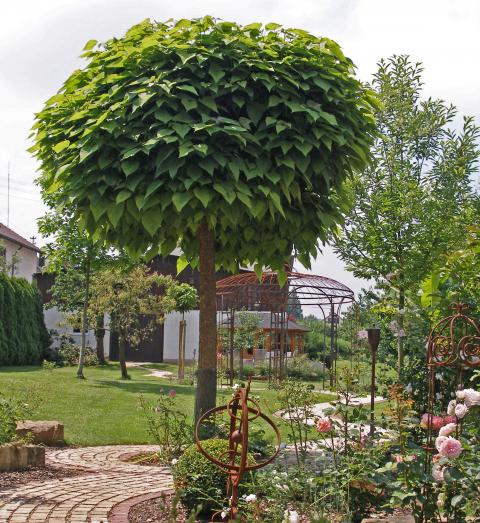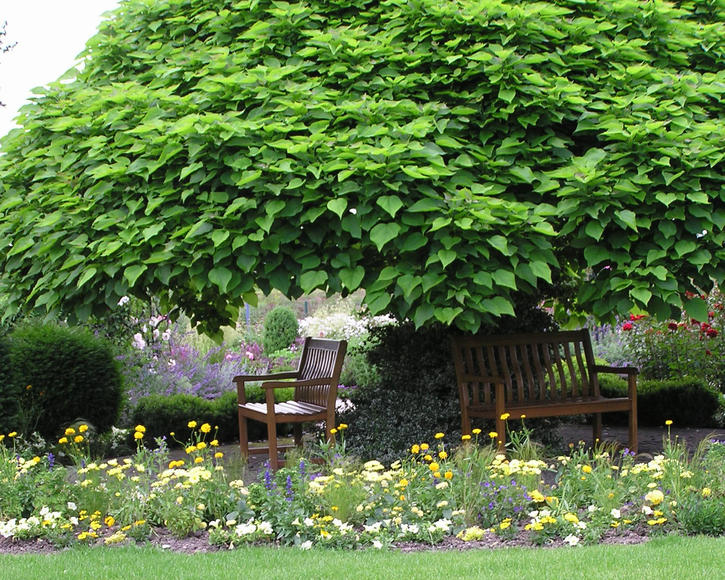Southern catalpa
Are you looking for a beautiful tree to provide shade for your seat? We recommend the Trumpet vine.
Factsheet
- Growth type
-
- small tree
- Growth height (from)
- from 1000 cm to 1200 cm
- Growth width (from)
- from 800 cm to 1200 cm
- Growth characteristics
-
- umbrella-shaped
- sweeping
- Flower color
-
- white
- Flowering time (month)
-
- June to July
- Flower shape
-
- Bells
- panicles
- Leaf color
-
- green
- page format
-
- heart-shaped
- Light
-
- sunny to scattered light
- Soil type
-
- sandy to loamy
- Soil Moisture
-
- moderately humid to humid
- ph value
-
- weakly alkaline to weakly acidic
- Lime compatibility
-
- lime-tolerant
- Nutrient requirements
-
- moderately nutritious
- Decorative or utility value
-
- Flower Decoration
- Fruit ornaments
- picturesque growth
- Nectar or pollen plant
- Toxicity
-
- weakly poisonous
- Winter Hardness
-
- hardy
- Climate zones according to USDA
-
- 6
- Use
-
- Single position
- house tree
- Street greening
- Garden style
-
- patio
- Park area
- Bee Friendly
- bee friendly plant
The Southern catalpa (Catalpa bignonioides) is native to the southeastern region of North America. It grows there on moist, nutrient-rich wetlands along the Mississippi and other large rivers. The botanical name Catalpa is of Native American origin. The tree is named for the bigonias family (Bignoniaceae), which also includes the Trumpet flower (Campsis radicans).
The medium-sized tree grows very quickly when young. It is not uncommon to see annual shoots 15.74 to 19.68 inches long in good soil. It often forms several trunks and, with age, a compact, a broad pyramidal and a spread out crown. The tips of the lower branches often hang down like a trail. In old age it reaches a height of 32.80 to 49.21 feet and a crown width of 26.24 to 39.37 feet. The thin bark of the old trunks is light gray to brownish and has long furrows. The trees are comparatively short-lived — after about 100 years they begin to degenerate.
The leaves are heart-shaped and strikingly large - up to 7.87 inches long and almost as wide. They are arranged opposite to each other or in a whorl in threes on the branches. On being crushed, they give off an unpleasant odor. The deciduous Southern catalpa is also called the "bureaucrat tree" among gardeners because it sprouts late and its leaves, which turn yellow-green leaves in fall, shed again in early autumn. When it comes to Photosynthesis he’s a real short-time worker.
The white, hermaphrodite bell flowers open in late May or early June. Inside they have a dark purple spot and a yellow stripe-like pattern. The flowers grow upright as multi-flowered panicle-like inflorescences.
The fertilized blossoms of the Southern catalpa form thick bean-shaped fruit capsules up to 13.77 inches long and 0.31 inch wide.
The location for the Southern catalpa should be sunny to partially shaded and a little sheltered from the wind, as the large leaves create high wind pressure. The Southern catalpa is not demanding, when it comes to soil. It grows best on moist, fertile loamy soils, but it can thrive on sandy substrates and can even handle summer drought quite well. In general, it is even recommended to plant the southern catalpa in not too nutrient-rich, moist places, as the shoots do not mature well until winter. The shoot tips then often freeze in winter and the wood is more prone to breakage in a storm.
The deciduous southern catalpa can also be kept as a container plant all year round. Bare-rooted specimens are planted in fall or spring. Special care measures are not required. One should mulch the root area to retain the moisture in the soil. Regular composting or fertilizer addition is not required. In winter, you should cover the trunks of young trees with bark that is still smooth or paint them white. They are very susceptible to frost cracks during frost and strong winter sun.
The Southern catalpa doesn’t require regular pruning or shaping. Shortening the main shoot and the side branches should also be avoided as much as possible in young plants, because the attachment points of the newly sprouting side branches or shoot extensions are at risk of breaking. Occasional radical trimming of the crown branches is only recommended for the spherical shaped “Nana”, if the crown is too wide and bulging.
The Southern catalpa is the perfect house tree if you have the right space in the garden and should definitely have a solitary location because of its imposing character. Under the sweeping, shade-giving crown, a cool summer seating area is almost striking. The fleshy, heart-shaped roots of the Southern catalpa can be combined well with Hostas, Ferns and other shade plants.
(Catalpa bignonioides “Nana”): The spherical shape of the Southern catalpa is popular as a house tree. As a young tree it forms a round and very dense crown that later becomes broad-oval. The tree becomes 13.12 to 19.68 feet high and wide, but does not bear any flowers or fruits.

Golden southern catalpa (C. bignonioides “Aurea”): The yellow-leaved variant is 26.24 to 32.80 feet high and 16.40 to 26.24 feet wide and is somewhat smaller than the wild species. Like the Southern catalpa “Nana”, the Golden southern catalpa is mostly offered as a crown finish on high trunks of the wild species.
Red-leaved Trumpet tree (C. x erubescens ‘Purpurea’): This is a red-leaved hybrid between C. bignonioides and C. ovata. The leaves are significantly smaller than those of C. bignonioides and slightly three-lobed. They grow black-red and green of the during summer. The white flowers in particular stand out from the leaves that are still red in June. At 26.24 to 32.80 feet tall and up to 26.24 feet wide, the hybrid remains smaller than the wild species.
The wild form of the southern catalpa is relatively easy to sow. The seeds should be harvested from older trees and should be well-ripened. It is dried a little over the winter and sown outdoors or in a seed box in spring. The soil should be sandy, rich in humus and not too rich in nutrients. It is important that it is warm enough, otherwise the seeds will not emerge or will only sprout poorly. The seedlings reach heights of 11.81 to 19.68 inches in the first year.
The varieties are usually propagated through grafting. Either through the winter manual grafting by splice grafting bare-root seedlings of the wild species or as standard grafting on planted tall trunks. Budding is often practiced in summer. All grafting methods have a very high success rate.
The Southern catalpa is somewhat susceptible to Verticillium wilt. The fungus spreads with its mycelium in the ducts and cuts off the water supply to individual branches, whereupon these suddenly wither and die. The disease occurs mainly in unfavorable soils and there is no cure. However, it can sometimes be stopped in young plants by transplanting the trees to another location with sandy, permeable soil. Powdery mildew also occasionally occurs on the leaves. However, it is not life-threatening.
Pests avoid the Southern catalpa as much as possible. Only voles can become a problem because they love to eat the fleshy roots of the plant.
In North America, the Southern catalpa is also important as a forest tree. Its beautifully grained wood is often used in furniture construction, for veneers and as parquet flooring. In addition, it is one of the most durable woods in the temperate zone and rots very slowly, even if it is in constant contact with the ground. All parts of the plant except for the seeds contain the slightly poisonous catalpin.
Frequently Asked Questions
What does a Southern catalpa look like?
The Southern catalpa is a tree up to 39.37 feet high, which is characterized by a very sprawling, pyramidal crown and large, heart-shaped leaves.
When do the leaves of the Southern catalpa sprout?
The Southern catalpa is truly a late bloomer among the trees. The leaves only sprout in late April or early May, which fall off again in early fall. That is why it is affectionately known as the "bureaucrat tree" among gardeners — comes late, leaves early.
When does the Southern catalpa bloom?
The Southern catalpa opens its white, bell-shaped flowers between late May and July.
When can you plant a Southern catalpa?
As a container, the Southern catalpa can be planted all year round. For bare-root specimens, planting in spring or autumn is recommended.
What fertilizer does a Southern catalpa need?
The Southern catalpa does not need to be fertilized regularly. However, it is advisable to mulch the root area . This keeps the soil nice and moist.
When do you have to prune the Southern catalpa?
The Southern catalpa doesn’t need regular pruning. Only with the Ball trumpet tree (Catalpa bignonioides ‘Nana’) is an occasional pruning recommended in late winter, as soon as the crown becomes too bulging.
Why doesn’t a Southern catalpa bloom?
If a Southern catalpa does not bloom, it could be because: 1. It is a non-flowering specimen. For example, no flowers bloom on the Ball trumpet tree “Nana”. 2. The tree is in the wrong location or wasn’t maintained properly, for example, the tree experienced drought stress. 3. The tree is still young. Some species do not bloom until they are eight to ten years old.



